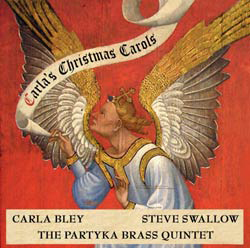 Jazz composer Carla Bley’s spent a career examining American vernacular music, so it’s just as weirdly inevitable that she’d eventually get around to Christmas music as it was for Bob Dylan. The results on Carla’s Christmas Carols are just as transforming as Dylan’s, though with more melodic results. Obviously.
Jazz composer Carla Bley’s spent a career examining American vernacular music, so it’s just as weirdly inevitable that she’d eventually get around to Christmas music as it was for Bob Dylan. The results on Carla’s Christmas Carols are just as transforming as Dylan’s, though with more melodic results. Obviously.
The album is a collaboration with Bley, Steve Swallow and the Partyka Brass Quintet that came about as part of a commission to create works for the Philharmonie in Essen, Germany, and the quintet’s use of less common horns – flugelhorn and bass trombone particularly – plays to Bley’s attention to texture. The horns pulse minimally, the individual characters of their instruments diminished as a trumpet states the melody and takes an extended solo on “Jingle Bells,” but “It Came Upon a Midnight Clear” references New Orleans with a big, muted trumpet and Ed Paryka’s swinging tuba while the other move en masse framing the solos.
Typical of Bley’s compositions, musical vocabularies merge within the pieces on Carla’s Christmas Carols. She can give herself over to the nostalgia of “The Christmas Song,” but the track gives way to a genuinely romantic post-bop sax solo as the rest of the ensemble swells behind them. Examinations of melody swiftly slide into the blues, and stately hymns suddenly swing. In “O Holy Night,” that happens when her piano becomes the primary accompaniment for Steve Swallow’s bass solo – one of the rare occasions on the album where they step into the spotlight. The roles are reversed when she takes on “God Rest Ye Merry Gentlemen” accompanied only by Swallow for much of the track, performing a subtle solo that’s as elegant as it is discreet until the horns join the track halfway through.
Bley’s sense of humor is less obvious here. Often, her tongue is gently, almost imperceptibly in her cheek, and that may be the case here. In a letter that accompanied the press release of the album, she recalls playing “Jingle Bells” as a soca and an occasion when she assigned students a pitch that they had to sing on demand, then conducting them on carols, referring to the singers that she played as “the Humatron.” Clearly, there’s a sense of humor and play at the heart of her relationship to this material, and her arrangements and new material reflects that, matched with a respect for the role the holiday and these songs play in people’s lives.




